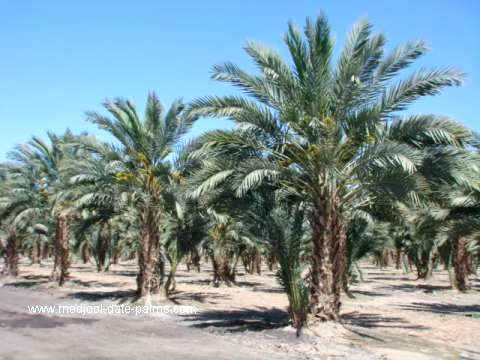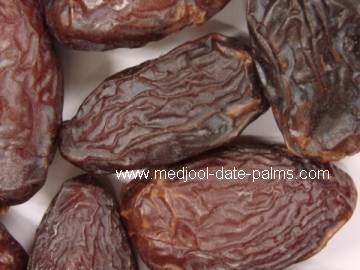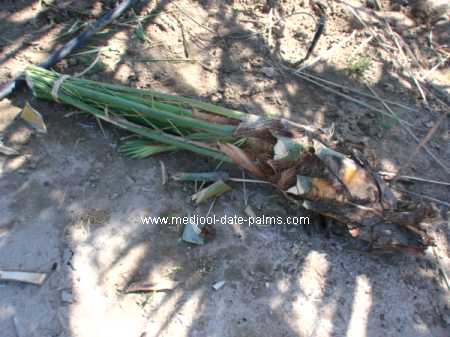Date Palm Historical Information
Date palms were one of the first plants cultivated by man. The first written records of date palms being grown and harvested are from about 5000 years ago in ancient Mesopotamia (current day Iraq) along the Tigris and Euphrates rivers. Date palms were also used 6000 years ago near Ur in Southern Iraq in the construction of the temple of the moon god. Archaeological research into ancient dwelling sites of Akadians, Sumerians, and Babylonians has shown that houses of these ancient peoples were roofed with date palm trunks and fronds.
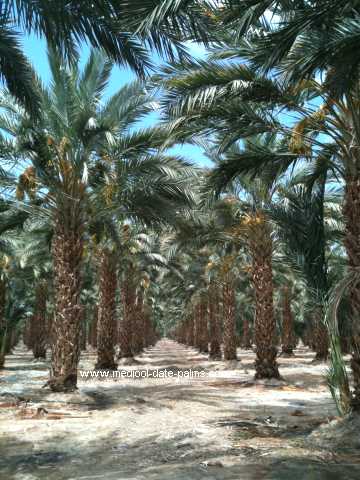
The scientific name for the date palm is phoenix dactylifera, and it is popularly known simply as the date palm. Although commonly referred to as a "palm tree", date palms are actually a true palm and not a tree. All palms, including the date palm, belong to a group of plants that are known as monocotyledons which include grasses, bamboos, hostas, lilies, daffodils, irises, palms, and orchids.
There are many other palms that produce edible drupes or dates, however their "dates" are almost all seed with very little flesh and most are quite small. Only phoenix dactylifera - the true "date palm" produces the large edible dates that are cultivated and sold today. The female phoenix dactylifera palm yields dates that measure from 1 to 3 inches long with varying degrees of sweetness. There are hundreds of named varieties of phoenix dactylifera date palms, and one of the most famous is the large soft Medjool date palm, while the most widely grown date is the semi-dry Deglet Noor date palm. A few of the other famous date palm varieties which are available in California are the Barhi date palms, the Zahidi date palm, and the Halawi date palm. Each of these date palm varieties produce delicious dates with distinct differences in flavor, sweetness, moisture content, and size.
Phoenix dactylifera date palms have been cultivated by man since the begining of recorded history. The name of the ancient land of Phoenicia actually means "land of palms", and many ancient Phoenician coins have images of date palms!
Date palms are mentioned in the bible, and their leaves were carried as symbols of victory by kings thousands of years ago. Date palm leaves were also used to hail Jesus during His entry into Jerusalem. Today Christian's have Palm Sunday, and Muslims break their Ramadan fast each night by eating a date. Islam regards the date palm tree as the tree of life, and ancient traditions place it in the Garden of Eden. The Prophet Mohammed said "There is among the trees, one which is blessed - it is the date palm, for it was created from the earth left over from the creation of Adam."
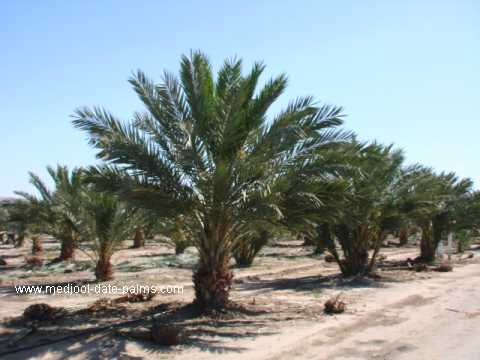
The date palm is not as well known in the USA, but it is very important in the Middle East and Northern Africa because the date palm grows well in the dry desert heat of these areas. In the past, dates had a very important role in these desert regions as the staple food crop. It was comparable to rice, wheat, and potatoes in other cultures! Even today the date palm is still the most important food plant of the great deserts of the Old World. The date palm's importance is not only for the food value of the dates themselves, but also for the partial shade of the date palm under which it was possible to cultivate other fruit trees that could not exist if exposed to the full dry heat of the desert sun.
For commercial date production, the top date producing regions today are the Middle East and North Africa. Iraq was the largest producer of the dates, although today Iran is thought to be the largest producer. Saudi Arabia is another major producer of dates and their national symbol has date palms. Libya, Tunisia, and Algeria produce large commercial quantities of dates, and these countries also have date palms on their stamps and currency.
In the USA, dates are being grown in Southern California, Southwestern Arizona, and around Las Vegas, Nevada.
Dates are also grown in some areas of Mexico and in South America, as well as in Australia, Western China, Western India, and in Southern Pakistan. According to the World Food and Agricultural Organization, there are an estimated 100 million date palm trees worldwide. An estimated 60% of all date palms are grown in the Middle East and North Africa.
Growing Medjool Date Palms in California
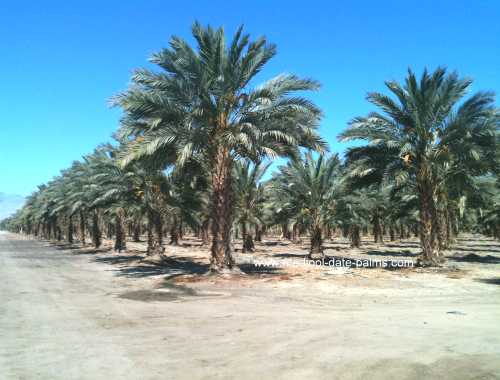
In the last few decades, the amazing medjool date palm has become very widely planted from the beaches of Southern California all the way across the State to the deserts along the California-Arizona & Nevada borders, both as landscape palms and also for date production in some areas. Medjool date palms are also being grown in several other USA states including Texas, Louisiana, Florida, Arizona and Nevada.
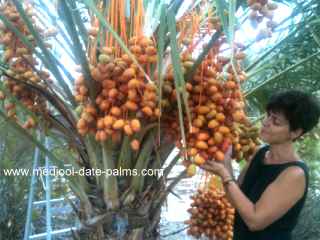 Increasing numbers of California homeowners are planting medjool date palms in their yards to harvest a yearly crop of home grown medjool dates!
Increasing numbers of California homeowners are planting medjool date palms in their yards to harvest a yearly crop of home grown medjool dates!
Medjool date palms are also being very widely planted today for their tropical landscape appeal. These regal date palms have become a very popular choice for both residential and commercial building landscape designs.
Some of the date palms used in landscaping are males and some are females. The female date palms are very desirable not only for their delicious dates but also for the tropical look they give to any landscape. Both male and female date palms are very popular because of their striking appearance & natural beauty, their ancient history & religious significance, and also because of their easy maintenance. A date palm can be very impressive as a single specimen, and group plantings can be truly spectacular. The date palm can live to the age of about 200 years, and they can eventually reach heights of over 80 feet tall.

Date palms grow very well in most of Southern California, and in some parts of the State further north as well. Male date palms are often used in landscaping because once mature they do not yield the annual crop of dates which can sometimes attract pests. For female date palms, there are three main date palm varieties most often planted in California; the Medjool date palm, the Zahidi date palm, and the Deglet Noor date palm. Another less well know date palm variety that is also very desirable for its dates and for landscaping is the Halawi date palm, which is even larger than the Medjool date palm.
Deglet Noor date palms are also very commonly planted in shopping centers and malls in southern California where they lend a striking tropical ambience.
Medjool date palms have a larger and more full dense canopy when compared to the Deglet Noor, which has a canopy that is more sparse and open with fewer fronds. The Medjool and Zahidi date palms are very similar in appearance with beautiful silvery green foliage. The Zahidi date palm does have a slightly larger trunk than the Medjool and the Zahidi's canopy is slightly more full and dense - truly a beautiful landscape specimen.
Medjool date palms in California like full sun and lots of water in the summertime. They are very drought hardy and salt tolerant, and they can survive extended periods without watering once they are established.
Mature medjool date palms can withstand temperatures falling to several degrees below freezing for short periods.
For date production, medjool date palms require plenty of summertime heat & sun and air with little moisture. The medjool date palms also require frequent irrigation during the hot summer months to yield a larger crop of dates!
Newly planted medjool date palm offshoots require frequent watering until they are well established.
Fresh cut date palm offshoots are very perishable.
Because fresh cut date palm offshoots are very sensitive to moisture loss and can perish even when cared for by professionals, we recommend that you buy medjool date palm rooted offshoots, rather than purchasing fresh cut medjool date palm offshoots.
Likewise, we recommend that you purchase already rooted medjool date palm offshoots in containers, rather than buying freshly dug up palms from the field since fresh-dug date palms often suffer severe shock and varying amounts of die-back.
Rooted date palm off-shoots in containers suffer no die-back and continue growing vigorously when planted properly.
In California, please call 909 941 1060 to purchase medjool date palm rooted offshoots in containers.
Medjool Date Palm Offshoots
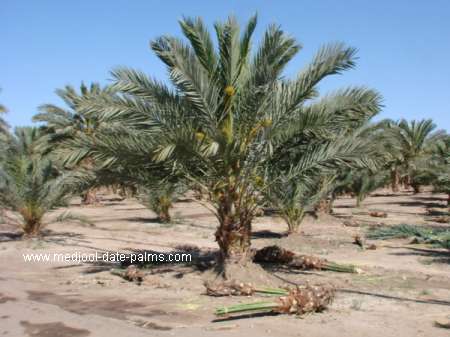

Phoenix dactylifera produces identical off-shoots in its early years, and these can be removed and planted. For more than 5000 years, the removal and planting of these pups or offshoots was the only way that a particular variety of date palm could be propagated, and by this means superior quality date palm cultivars could be selectively planted and passed down from one generation to the next. Some date palm cultivars like the zahidi date palm are several thousand years old!
When female date palm off-shoots are planted directly out in the field, they can begin to produce dates about 5 years after being planted. However, when off-shoots are planted directly out in the field without first developing their own roots, these freshly removed date palm offshoots can experience much more dehydration and frequently do not survive.
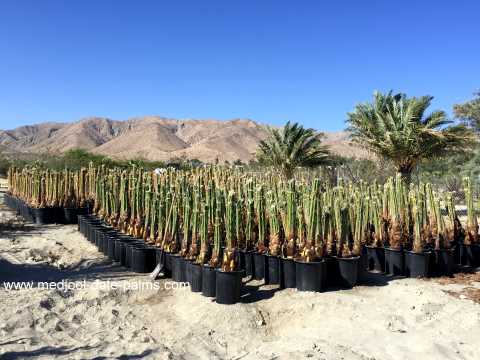
Immediately after date palm offshoots are removed, they are taken to the field for planting or planted into large pots or wooden boxes. These potted offshoots will take 1-2 years to develop their own roots & begin pushing out new vigorous foliage. At this stage the offshoots are known as rooted offshoots. They are now ready to be sold!
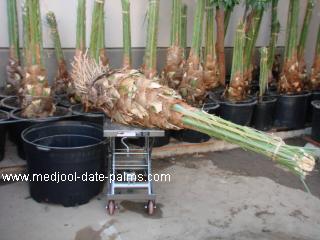
Larger rooted offshoots can begin producing dates in just one year after being carefully removed from their pot or box & then planted out in the field! We do have these larger rooted medjool date palm offshoots in stock right now - call 909 941 1060 for sales info in California.
Each year we remove a large number of medjool date palm offshoots in a variety of sizes and we plant them into a variety of different container sizes (pots and boxes) to be sold or re-planted later.
Our smallest size of medjool date palm offshoots are removed from the mother palm at about six years of age when they have about one foot of woody trunk. We plant them into 15 gallon pots, and they weigh about 100 pounds in their 15 gallon container with the soil.
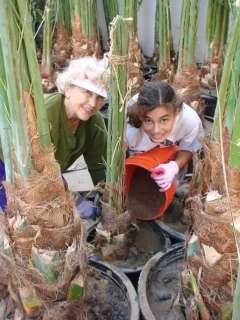
We also have large rooted medjool offshoots available in very big pots and wooden boxes with several feet of woody trunk!
For medjool date palm offshoot sales information in California, call 909 941 1060.
We have some larger rooted medjool date palm offshoots in big pots that are already producing dates!
Date Palm Seedlings
Date palms can also be grown from seed, however only about half the palms grown from seed will be females, and the quality of the dates from these female seedlings will vary and be of generally inferior quality to extablished date palm cultivars.
In date palm seedling plantations, only about 10% of the palms produce fruit of satisfactory quality, and the dates from each of these seedlings are different from one seedling to the next. Marketing these non-uniform dates from a seedling plantation is difficult at best. Female date palms grown from seed also take a long time to produce dates, usually 10-12 years or more. The non-uniform crop from seedling date palm plantations is the primary reason for the recent abandonment of seedling date palm plantations worldwide in favor of date palm off-shoot plantations.
In recent years, scientists have developed tissue culture reproduction techniques of specific date palm varieties, however such propagation methods are not normally employed in commercial plantings.
Male Date Palm Flowers, Date Palm Pollen, and Medjool Date Palm Pollination
Phoenix dactylifera date palms are dioecious, meaning that there are both male date palms and female date palms. The male date palm has flowers that produce the pollen, and the female date palm has flowers which will become dates, if they are pollinated.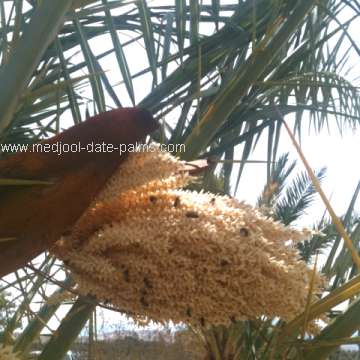
The flower stalks of both male and female date palms are produced inside a spathe. The spathe emerges from the axils of the leaves in early spring in mature date palms. The date palm flowers form within the long stout spathe which, on bursting, exposes many thickly crowded floral branchlets inside which are thicker and shorter in the male date palm inflorescence, and the branchlets are long and slender in female date palm inflorescence. Adult female date palms produce from 5 - 20 spathes in early spring. The male flowers are borne single and are waxy white, while the female flowers are borne in clusters of three and are yellowish green in colour. A male spathe that is ready to split open changes color from green to brown and it becomes slightly softer. Immediately after the spathe opens and the male inflorescence appears, these male flowers reach their maturity. Date growers usually harvest the male flowers within a day of when the spathe splits open.
We have fresh male date palm flowers available in March and April each year for use in pollination, and also as a source of fresh date palm pollen.
To purchase fresh date palm male flowers (and date palm pollen), call (909) 941 1060.
There are several methods of date palm polination in use today. The oldest and simplest pollination technique consists of placing an entire male flower spathe in the crown of the female date palm and leaving the pollination to wind, bees and other insects. This technique does not always yield uniform fruit sets unless if several of the male flower spathes are placed in the crown of the female date palm. This requires the availability of numerous male flower spathes.
Successful commercial date production requires artificial pollination to ensure good pollination. In locations where labor is relatively expensive, the pollination is mechanized. Mechanized pollination reduces the number of male date palms needed for pollination. The male/female ratio in a modern commercial date palm plantation with mechanized pollination is generally about 40 females to one male date palm. The most common technique of pollination in regions with inexpensive labor is to cut the strands of male flowers from a freshly opened male spathe and place two to three of these strands, lengthwise and in an inverted position, between the strands of the female inflorescence after some pollen has been shaken over the female inflorescence.
Medjool Date Palms Used For Landscaping
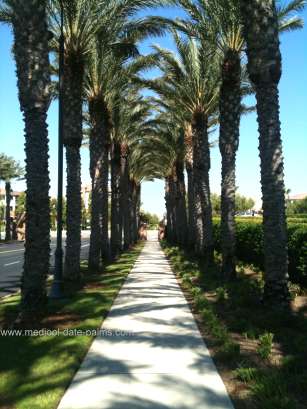
Date palms are very popular due to their striking regal appearance, their natural beauty, and also because of their easy maintenance. There also is considerable renewed interest in the date palm because of the date palm's ancient history and religious significance. A date palm can be very impressive as a single specimen, and group plantings can be truly spectacular. The date palm can live to the age of about 200 years, and they can eventually reach heights of about 80 feet tall.
Date palms grow well throughout Southern California where they are used mostly in landscaping.
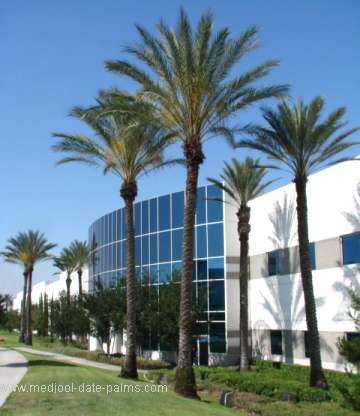
Deglet Noor date palms are commonly planted in shopping centers and malls in southern California where they lend a striking tropical ambience.

Medjool date palms grow taller each year, and it becomes more costly and dangerous to harvest the dates as they get taller.
Commercial date growers in California usually end up selling their older date palms that have become too tall for harvesting dates. These large date palm specimens are ideal for many landscaping projects!
In Southern California it not unusual to see tall date palm specimens providing shade in the parking lots of convenience stores and fast food restuarants. Date palms are also very popular in landscape designs for commercial buildings.
Date Development and Ripening Stages
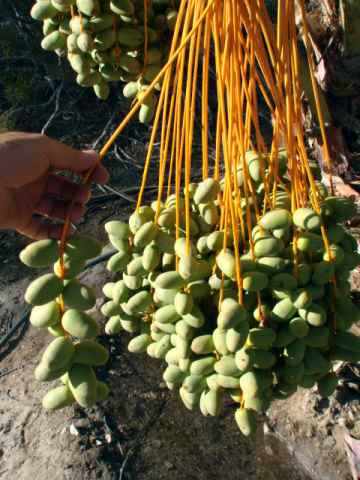
The kimri stage lasts about 5 months and is basically while the dates are green. The next ripening stage is the khalal stage when the dates have grown to their maximum size and turn yellowish or reddish depending on the specific date variety. Next comes the rutab stage, when the dates begin to soften and lose their bright colors. The date becomes fully mature at the tamar stage.
Most date varieties are eaten at the fully mature tamar stage, although some of the very soft varieties like the the Barhi dates and the the Halawi dates are also eaten at Khalal stage, when they are sweet and crunchy. We have fresh dates available each year at this khalal stage of ripening.
The Honey Jewel date is also amazingly delicious, soft and very sweet like honey in its fully ripe tamar stage. The Honey Jewel date has been repeatedly voted as the most delicious date variety at our Fresh Picked Tamar Tastings the last 4 years in a row, winning out even over the famously popular medjool date.
Dates are classified as soft, semi-dry, and dry. The dry dates are commonly used in the middle east for everyday consumption. The sweeter dates are used as a dessert in the Middle East as well as in the United States.
Mature female date palms yield from 100 to 250 pounds of dates per palm each year. One of the most important factors in date yield is the amount of irrigation water they receive while the dates are developing.
While the dates are maturing on the palm, the dates are preyed upon by birds, small mammals, and insects. Date farmers sometimes place a protective bag around each date cluster to prevent access to the dates and also for rain protection in some climates. The cultivation of dates requires a significant amount of manual labor and it can be dangerous in tall palms! Some date varieties are much more vulnerable to moisture. Soft dates are much more difficult to cultivate and they do require extensive care & special handling at the final ripening stage.
Medjool Dates & Medjool Date Palms
Among the sweeter date varieties is the medjool date, which is considered by many to be the "king of dates". The medjool date was once reserved only for the royal family of the Sultan of Morocco! This amazing date palm variety was first imported into the USA from the Bou Denib Oasis in Morocco in 1927.
The medjool date is most well known for its unusually large size and its delicious flavor. It can grow to about three inches long, and even though it is classified as a soft date the medjool date is firmer and more resilient than most other soft dates and it handles much better as well, making it a great choice for commercial production.
The Medjool date was brought to the United States through the United States Department of Agriculture. There was a disease in Morocco that was spreading quickly among the Medjool date palms and a Moroccan official offered some shoots to a representative from the USDA which in turn were eventually planted in California. The medjool is now thriving in California as one of the primary date cultivars.
Medjool date palms are also very popular for landscaping because of their regal appearance and full canopy. Medjool date palms have a larger and more full dense canopy when compared to the Deglet Noor, which has a canopy that is more sparse and open with fewer fronds. The Medjool and Zahidi date palms are more similar in appearance with beautiful silvery green foliage.
How To Buy Medjool Date Palms & other Date Palm Varieties in California
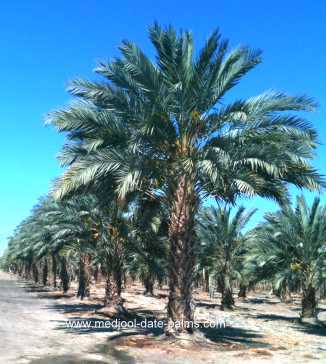
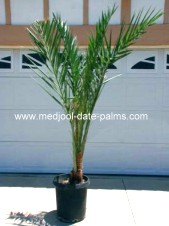
We specialize in already rooted date palm offshoots in containers. Please call 909 941 1060 for current date palm price & availablilty in California.
In addition to our male date palm offshoots, we offer a variety of female date palm cultivars including medjool date palms offshoots, zahidi date palm offshoots, halawi date palm offshoots, and barhi date palm offshoots.
Our Medjool date palm offshoots are available in all sizes from recently removed pups or "offshoots" to full grown mature palms.
We have female Zahidi date palm offshoots & Medjool date palm offshoots in stock right now, with more Barhi date palm offshoots and Halawi date palm offshoots available again soon.
Male date palms are a popular choice for use in landscaping, and also as a source of date palm pollen for pollination of female date palms. Female date palms produce dates, and they are planted in large plantations for commercial date production. Male date palms for landscaping are less expensive than most female date palm cultivars, while some female date palms grown from off-shoots of specific date cultivars have very limited availability and high demand.
We have smaller size female medjool date palm rooted offshoots for sale in 15 gallon pots & 25 gallon pots for those who wish to grow their own dates at home in their yard.
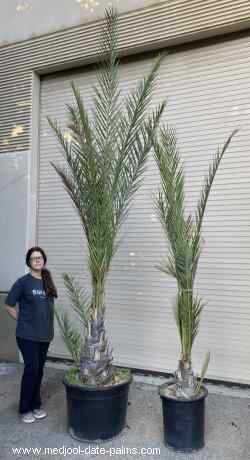
The photo at left shows rooted medjool date palm offshoots for sale in 15 gallon & 25 gallon containers.
These are vigorous well-rooted medjool offshoots with new green growth emerging, and they are ready to plant! With proper care, they will continue growing about one foot taller each year after planting in your yard.
In the photo at left, the smaller rooted medjool offshoot in the 15 gallon pot has about 10 inches of woody trunk above the ground, and the 25 gallon rooted medjool offshoot has about 18 inches (1.5 feet) of woody trunk above the ground.
This rooted medjool date palm offshoot with 1.5 feet of woody trunk above the ground is mature, and it is ready to produce medjool dates!
We have a few hundred rooted medjool date palm offshoots available for sale in this size right now
(please call 909 941 1060 for details).
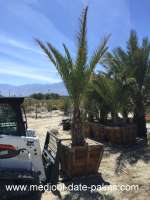
We offer larger rooted medjool date palms for sale in wood boxes as well. These mature date palms have from two feet to four feet of woody trunk, and they are ready to start producing delicious medjool dates!
In California, call (909) 941 1060 for details.
Larger size mature female medjool date palms are available for transplant directly from the field as well, however transplanted palms directly from the field go thru a period of die-back at the time of transplant while rooted offshoots in containers keep right on growing with no die-back when cared for properly.
Our smaller size male date palm offshoots are also for sale in 15 gallon pots and in 25 gallon pots (male date palms are used for polination & for landscaping).
Our female medjool date palm "rooted" offshoots are in containers. After these medjool palm pups are removed from their medjool mother palms, they have to develop their own roots which takes 1-2 years, and they then begin to put out new growth. Our 15 gallon size medjool date palm rooted off-shoots stand from 6 to 8 feet tall. These rooted medjool off-shoots are ready for planting. Please call 909 941 1060 for price information and how to purchase in California.
Older mature date palm trees are sold based on their age and the amount of woody trunk the palm has: a 12 foot tall date palm has about 2 feet of woody trunk, and a 20 foot tall date palm has about 10 feet of woody trunk.
Date palm rooted offshoots in containers experience no die-back when properly planted and cared for.
Larger date palms however, that are dug up in the field and shipped directly to the customer usually experience severe die-back lasting a year or more before vigorous growth returns, and a significant percentage often do not survive. For this reason, we always recommend planting rooted date palm offshoots in containers rather than purchasing date palms directly from the field.
Please call 909 941 1060 for current price & availablilty of rooted date palm off-shoots in containers.
Fresh Medjool Dates For Sale
We grow our delicious medjool dates organically with no chemicals, nothing added, and no preservatives; they are pure naturally sweet medjool dates! Did you know that medjool dates are 100% fat free? Our fresh picked medjool dates are available for purchase each year in October & November, just in time for Christmas!
This year, we will once again have a limited quantity of fresh picked organically grown large medjool dates available. Each year we do sell out before the crop is picked, so be sure to place your order early! We begin filling orders for fresh-picked medjool dates in September.
Honey Jewel DatesTM
A very sweet and delicious California date variety is the "new" cultivar named the Honey JewelTM date.
The Honey JewelTM date is amazingly delicious, soft and very sweet like honey in its fully ripe tamar stage of ripening.
The Honey JewelTM date has been repeatedly voted as the most delicious date variety at our Fresh Picked Tamar Tastings the last several years in a row, winning out even over the famously popular medjool date.
Dates are classified as soft, semi-dry, and dry. The Honey Jewel date is very soft at the fully ripe tamar stage.
We have fresh Honey Jewel dates available each year at their tamar stage of ripening when they are fully ripe and soft.
We begin harvesting for our Honey JewelTM date crop in late August each year.
Halawi Dates, and Halawi Date Palms
Halawi dates (also known as Halawy) are a very sweet soft date variety of medium size with wonderful caramel-honey like flavor. The halawi date palm variety originated in Mesopotamia and has been propagated by off-shoots for millenia. The name halawi actually means "sweet" in Arabic. In some cultures, the halawi date is eaten at the khalal stage when it has become yellow and is still crunchy like an apple. The flavor at this khalal stage is less sweet and very different. If allowed to ripen further, the halawi date will next enter the rutab stage where it begins to turn a beautiful golden-amber color as it softens and becomes very sweet and delicious.
Halawi date palms grow well in Southern California. When used for landscaping, the halawi date palm trunk and canopy are larger than both the medjool and the zahidi, making the halawi date palm a truly spectacular landscape palm specimen!
Our Halawi date crop begins ripening in August each year.
Zahidi Dates, and Zahidi Date Palms
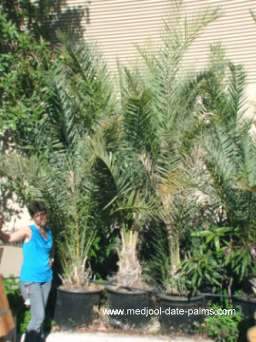
Zahidi date palms (in different regions, this variety is also known as Zehedi, Zadie, and originally from the Persian Azadi) yield a very sweet and delicious medium size date that is basically a dry date, although it can be used as a soft date or as a dry date depending on the length of time it is allowed to remain on the palm.
The zahidi date palm is an ancient cultivar from Mesopotamia dating back millenia, and the name meant Nobility in ancient Persian. Fully ripe zahidi dates have beautiful golden-yellow color and they are early season.
The Zahidi date palm rooted offshoots shown at left are 12 year old rooted off-shoots in 25 gallon pots.
We have female zahidi date palm offshoots available with special pricing. These rooted zahidi offshoots stand from 12-16 feet tall and have from 1-2 feet of woody trunk, and they are mature enough now to start producing dates! Please call (909) 941 1060 for pricing.
Zahidi date palms are very vigorous as well as prolific in fruiting, and they do grow well in Southern California. For landscaping, the zahidi date palm is among the finest of the date palms. The zahidi trunk and canopy is very similar to the medjool date palm with beautiful silvery green foliage, and the zahidi has a slightly more dense upright canopy than the medjool. Like the medjool, the zahidi date palm is highly prized for the quality and flavor of its dates, as well as for its majestic appearance.
We begin harvesting our Zahidi date crop in early September each year.
Date Nutritional Information
Dates are highly nutritional and many believe them to be one of natures most perfect foods! People of the Middle East have consumed the fruit of the date palm for thousands of years as part of their diet.Dates contain polyphenols, which are a plant antioxidant that can destroy disease causing free radicals.
Dates have 20 different kinds of amino acids, which aid in the digestive process. Dates are very rich in both vitamins and minerals, and they contain more potassium than an orange or a banana per ounce. These nutritious fruit of the date palm contain vitamins A, A1, B1, B2, B3, B5, and B6. Dates also are rich in oil, calcium, sulfur, iron, potassium, phosphorous, manganese, copper, protein and fiber. Dates are fat free, cholesterol free, and they are very low in sodium. Dates also are high in carbohydrates, and they are an excellent source of quick energy. Dates are helpful to people suffering with anemia and fatigue, and dates act as natural laxatives which can be an easy remedy for constipation. In most date varieties, the sugar content of a date is almost entirely of the inverted forms glucose and fructose (except for deglet noor dates and thoory dates which have higher percentages of sugar in the form of sucrose). This is very important important for people who cannot tolerate sucrose. The invert sugar in dates is immediately absorbed by the human body without the need for digestion that ordinary sugars like sucrose undergo.
Traditionally, the fruit of the date palm has been used for treating many kinds of ailments in the Islamic world including the treatment of respiratory disorders, and to stimulate the heart rate. Dates also have traditionally been processed into a salve for treating certain kinds of wounds. The fruit of the true date palm also is recommended for consumption by lactating women to add extra nutrition into their diet. The Plant Sciences Division website at the University of California at Davis, states that Bedouin Arabs who eat dates on a regular basis have shown an extremely low incidence of cancer and heart disease when compared with people who do not eat dates regularly.
Dates also are an excellent choice for emergency food rations because of the date's high caloric content & nutritional value combined with the fact that dates keep well without refrigeration for long periods of time.
Frequently Asked Questions
- SHIPPING: For medjool date palm offshoots in 15 & 25 gallon containers, we recommend that you transport the date palms in your pick-up truck. Local delivery to your driveway can usually be arranged (only in Southern California) with a delivery cost from $50 to $150 depending on the round-trip mileage (50 mile maximum round-trip travel distance). Transport for large medjool date palms can also be arranged in Southern California.
- Our medjool dalm palm rooted offshoots (and our other date palm cultivars) are grown near Indio, California. Smaller size medjool date palms are available for pick-up in Rancho Cucamonga, California, by appointment only. Delivery of medjool date palm trees to customers in Southern California can be arranged. We do recommend that you hire an experienced landscaper (we do not offer landscaping services!) for planting and irrigation of date palms.
- Sub Tropical Fruit Trees: Available for pick-up in Rancho Cucamonga, California, by appoinment only, at one of our two locations.
- PAYMENT: We accept Cash, Check, American Express, Visa, Mastercard & Discover. You can pay in advance or at the time of pick up.
- MEDJOOL DATES: fresh picked medjool dates are available each year in October, organically grown in California.
- GUARANTEE: We guarantee our plants, fruits and trees to be in good condition at the time of sale.
- For all other questions, you may contact us at: Tropical Oasis Farms, PO Box 1011, Rancho Cucamonga, California 91729
© Copyright 2000-2025
